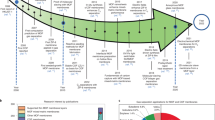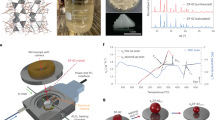Abstract
Membranes with ultrahigh permeance and practical selectivity could greatly decrease the cost of difficult industrial gas separations, such as CH4/N2 separation. Advanced membranes made from porous materials, such as metal–organic frameworks, can achieve a good gas separation performance, although they are typically formed on support layers or mixed with polymeric matrices, placing limitations on gas permeance. Here an amorphous glass foam, agfZIF-62, wherein a, g and f denote amorphous, glass and foam, respectively, was synthesized by a polymer-thermal-decomposition-assisted melting strategy, starting from a crystalline zeolitic imidazolate framework, ZIF-62. The thermal decomposition of incorporated low-molecular-weight polyethyleneimine evolves CO2, NH3 and H2O gases, creating a large number and variety of pores. This greatly increases pore interconnectivity but maintains the crystalline ZIF-62 ultramicropores, allowing ultrahigh gas permeance and good selectivity. A self-supported circular agfZIF-62 with a thickness of 200–330 µm and area of 8.55 cm2 was used for membrane separation. The membranes perform well, showing a CH4 permeance of 30,000–50,000 gas permeance units, approximately two orders of magnitude higher than that of other reported membranes, with good CH4/N2 selectivity (4–6).
This is a preview of subscription content, access via your institution
Access options
Access Nature and 54 other Nature Portfolio journals
Get Nature+, our best-value online-access subscription
$29.99 / 30 days
cancel any time
Subscribe to this journal
Receive 12 print issues and online access
$259.00 per year
only $21.58 per issue
Buy this article
- Purchase on Springer Link
- Instant access to full article PDF
Prices may be subject to local taxes which are calculated during checkout




Similar content being viewed by others
Data availability
The authors declare that all data supporting this study are available within the paper and Supplementary Information. Source data are provided with this paper.
References
Brown, A. J. et al. Interfacial microfluidic processing of metal-organic framework hollow fiber membranes. Science 345, 72–75 (2014).
Zhang, C., Wu, B., Ma, M., Wang, Z. & Xu, Z. Ultrathin metal/covalent–organic framework membranes towards ultimate separation. Chem. Soc. Rev. 48, 3811–3841 (2019).
Sholl, D. S. & Lively, R. P. Seven chemical separations to change the world. Nature 532, 435–438 (2016).
Zhou, S. et al. Asymmetric pore windows in MOF membranes for natural gas valorization. Nature 606, 706–712 (2022).
Qiao, Z. et al. Metal-induced ordered microporous polymers for fabricating large-area gas separation membranes. Nat. Mater. 18, 163–168 (2019).
Lin, H., Wagner, E. V., Freeman, B. D., Toy, L. G. & Gupta, R. P. Plasticization-enhanced hydrogen purification using polymeric membranes. Science 311, 639–642 (2006).
Park, H. B., Kamcev, J., Robeson, L. M., Elimelech, M. & Freeman, B. D. Maximizing the right stuff: the trade-off between membrane permeability and selectivity. Science 356, 1138–1148 (2017).
Peng, Y. et al. Metal-organic framework nanosheets as building blocks for molecular sieving membranes. Science 346, 1356–1359 (2014).
Ma, X. et al. Zeolitic imidazolate framework membranes made by ligand-induced permselectivation. Science 361, 1008–1011 (2018).
Knebel, A. et al. Defibrillation of soft porous metal-organic frameworks with electric fields. Science 358, 347–351 (2017).
Liu, G. et al. Mixed matrix formulations with MOF molecular sieving for key energy-intensive separations. Nat. Mater. 17, 283–289 (2018).
Boyd, P. G. et al. Data-driven design of metal–organic frameworks for wet flue gas CO2 capture. Nature 576, 253–256 (2019).
Zhao, S. et al. Hydrophilicity gradient in covalent organic frameworks for membrane distillation. Nat. Mater. 20, 1551–1558 (2021).
Jeon, M. Y. et al. Ultra-selective high-flux membranes from directly synthesized zeolite nanosheets. Nature 543, 690–694 (2017).
Kuznicki, S. M. et al. A titanosilicate molecular sieve with adjustable pores for size-selective adsorption of molecules. Nature 412, 720–724 (2001).
Rose, I. et al. Polymer ultrapermeability from the inefficient packing of 2D chains. Nat. Mater. 16, 932–937 (2017).
Baran, M. J. et al. Diversity-oriented synthesis of polymer membranes with ion solvation cages. Nature 592, 225–231 (2021).
Lai, H. W. H. et al. Hydrocarbon ladder polymers with ultrahigh permselectivity for membrane gas separations. Science 375, 1390–1392 (2022).
Marius, S. et al. An integrated materials approach to ultrapermeable and ultraselective CO2 polymer membranes. Science 376, 90–94 (2022).
Adil, K. et al. Gas/vapour separation using ultra-microporous metal–organic frameworks: insights into the structure/separation relationship. Chem. Soc. Rev. 46, 3402–3430 (2017).
Li, J.-R., Kuppler, R. J. & Zhou, H.-C. Selective gas adsorption and separation in metal–organic frameworks. Chem. Soc. Rev. 38, 1477–1504 (2009).
Ding, M., Flaig, R. W., Jiang, H.-L. & Yaghi, O. M. Carbon capture and conversion using metal–organic frameworks and MOF-based materials. Chem. Soc. Rev. 48, 2783–2828 (2019).
Li, J.-R., Sculley, J. & Zhou, H.-C. Metal–organic frameworks for separations. Chem. Rev. 112, 869–932 (2012).
Furukawa, H., Cordova, K. E., O’Keeffe, M. & Yaghi, O. M. The chemistry and applications of metal-organic frameworks. Science 341, 1230444 (2013).
Lin, J. Y. S. Molecular sieves for gas separation. Science 353, 121–122 (2016).
Livingston, A. & Baker, R. Membranes from academia to industry. Nat. Mater. 16, 280–282 (2017).
Merkel, T. C., Lin, H., Wei, X. & Baker, R. Power plant post-combustion carbon dioxide capture: an opportunity for membranes. J. Membr. Sci. 359, 126–139 (2010).
Al-Maythalony, B. A. et al. Quest for anionic MOF membranes: continuous sod-ZMOF membrane with CO2 adsorption-driven selectivity. J. Am. Chem. Soc. 137, 1754–1757 (2015).
Gaillac, R. et al. Liquid metal–organic frameworks. Nat. Mater. 16, 1149–1154 (2017).
Widmer, R. N. et al. Pressure promoted low-temperature melting of metal–organic frameworks. Nat. Mater. 18, 370–376 (2019).
Frentzel-Beyme, L., Kloss, M., Kolodzeiski, P., Pallach, R. & Henke, S. Meltable mixed-linker zeolitic imidazolate frameworks and their microporous glasses: from melting point engineering to selective hydrocarbon sorption. J. Am. Chem. Soc. 141, 12362–12371 (2019).
Hou, J. et al. Liquid-phase sintering of lead halide perovskites and metal-organic framework glasses. Science 374, 621–625 (2021).
Wang, Y. et al. A MOF glass membrane for gas separation. Angew. Chem. Int. Ed. 59, 4365–4369 (2020).
Li, J. et al. Coordination polymer glasses with lava and healing ability for high-performance gas sieving. Angew. Chem. Int. Ed. 133, 21474–21479 (2021).
Yang, S. et al. Robust bifunctional compressed carbon foam for highly effective oil/water emulsion separation. ACS Appl. Mater. Interfaces 12, 44952–44960 (2020).
Li, W. et al. Covalent organic polymer nanoparticle-supported monolithic foams for separation of nitrotoluene isomers. ACS Appl. Nano Mater. 4, 10864–10876 (2021).
Tan, C., Lee, M. C., Arshadi, M., Azizi, M. & Abbaspourrad, A. A spiderweb-like metal–organic framework multifunctional foam. Angew. Chem. Int. Ed. 59, 9506–9513 (2020).
Cui, Z. et al. Preparation of 3-D porous PVDF/TPU composite foam with superoleophilic/hydrophobicity for the efficient separation of oils and organics from water. J. Membr. Sci. 56, 12506–12523 (2021).
Longley, L. et al. Metal-organic framework and inorganic glass composites. Nat. Commun. 11, 5800 (2020).
Li, S. et al. A new route to porous metal–organic framework crystal–glass composites. Chem. Sci. 11, 9910–9918 (2020).
Stepniewska, M., Stergaard, M. B., Zhou, C. & Yue, Y. Towards large-size bulk ZIF-62 glasses via optimizing the melting conditions. J. Non Cryst. Solids 530, 119806 (2020).
Thorne, M. F., Gómez, M. L. R., Bumstead, A. M., Li, S. & Bennett, T. D. Mechanochemical synthesis of mixed metal, mixed linker, glass-forming metal–organic frameworks. Green Chem. 22, 2505–2512 (2020).
Horike, S. & Kitagawa, S. Unveiling liquid MOFs. Nat. Mater. 16, 1054–1055 (2017).
Bennett, T. D., Coudert, F. X., James, S. L. & Cooper, A. I. The changing state of porous materials. Nat. Mater. 20, 1179–1187 (2021).
Horike, S., Nagarkar, S. S., Ogawa, T. & Kitagawa, S. A new dimension for coordination polymers and metal–organic frameworks: towards functional glasses and liquids. Angew. Chem. Int. Ed. 59, 6652–6654 (2020).
Bennett, T. D. et al. Melt-quenched glasses of metal–organic frameworks. J. Am. Chem. Soc. 138, 3484–3492 (2016).
Carreon, M. Molecular sieve membranes for N2/CH4 separation. J. Mater. Res. 33, 32–43 (2018).
Niu, Z. et al. A metal–organic framework based methane nano-trap for the capture of coal-mine methane. Angew. Chem. Int. Ed. 58, 10138–10141 (2019).
Yang, R. T. Adsorbents: Fundamentals and Applications (John Wiley & Sons, 2003).
Mohamed, M. H. et al. Designing open metal sites in metal organic frameworks for paraffin/olefin separations. J. Am. Chem. Soc. 141, 13003–13007 (2019).
Demir, H. et al. Metal−organic frameworks with metal−catecholates for O2/N2 separation. J. Phys. Chem. C 123, 12935–12946 (2019).
Buonomenna, M. G. et al. Nanostructured poly(styrene-b-butadiene-b-styrene) (SBS) membranes for the separation of nitrogen from natural gas. Adv. Funct. Mater. 22, 1759–1767 (2012).
Wang, S., Guo, Q., Liang, S., Li, P. & Luo, J. Preparation of Ni-MOF-74/SBS mixed matrix membranes and its application of CH4/N2 separation. Sep. Purif. Technol. 199, 206–213 (2018).
Ashling, C. W. et al. Synthesis and properties of a compositional series of MIL-53(Al) metal–organic framework crystal-glass composites. J. Am. Chem. Soc. 141, 15641–15648 (2019).
Collins, S. M. et al. Subwavelength spatially resolved coordination chemistry of metal–organic framework glass blends. J. Am. Chem. Soc. 140, 17862–17866 (2018).
Mubashir, M. et al. Cellulose acetate-based membranes by interfacial engineering and integration of ZIF-62 glass nanoparticles for CO2 separation. J. Hazard. Mater. 415, 125639 (2021).
Lin, R. et al. Interfacial engineering of a polymer–MOF composite by in situ vitrification. Chem. Commun. 56, 3609–3612 (2020).
Li, S. et al. Mechanical properties and processing techniques of bulk metal–organic framework glasses. J. Am. Chem. Soc. 141, 1027–1034 (2019).
Yu, X. et al. Novel tertiary amino containing thin film composite membranes prepared by interfacial polymerization for CO2 capture. J. Membr. Sci. 362, 265–278 (2010).
Guo, X., Huang, H., Liu, D. & Zhong, C. Improving particle dispersity and CO2 separation performance of amine-functionalized CAU-1 based mixed matrix membranes with polyethyleneimine-grafting modification. Chem. Eng. Sci. 189, 277–285 (2018).
Zhou, C. et al. Metal-organic framework glasses with permanent accessible porosity. Nat. Commun. 9, 5042 (2018).
Xia, R. et al. Probing sub-nano level molecular packing and correlated positron annihilation characteristics of ionic cross-linked chitosan membranes using positron annihilation spectroscopy. Phys. Chem. Chem. Phys. 19, 3616–3626 (2016).
Acknowledgements
This research was supported by the National Key R&D Program of China (no. 2021YFB3802200) and the National Natural Science Foundation of China (grant nos. 21875161, 22038010, 22141001 and 22122810). M.D.G. is grateful for the financial support of the State Key Laboratory of Engines, Tianjin University.
Author information
Authors and Affiliations
Contributions
Z.Y., Z.Q. and S.L. fabricated the membranes and conducted the characterization. C.Z., Z.Q., M.D.G., T.D.B., Y.B., L.N.M., S.L., D.A. and Y.S. helped with experimental design, the membrane formation mechanism and data analyses. Z.Q., Z.Y., C.Z., M.D.G., T.D.B., Y.B. and L.N.M. wrote the paper.
Corresponding authors
Ethics declarations
Competing interests
The authors declare no competing interests.
Peer review
Peer review information
Nature Materials thanks Weishen Yang and the other, anonymous, reviewer(s) for their contribution to the peer review of this work.
Additional information
Publisher’s note Springer Nature remains neutral with regard to jurisdictional claims in published maps and institutional affiliations.
Supplementary information
Supplementary Information
Supplementary Figs. 1–43, Tables 1–10, Materials and refs. 1–22.
Source data
Source Data Fig. 1
Source data for X-ray scattering factors plotted in Fig. 1b, pair distribution functions plotted in Fig. 1c, pore size distributions plotted in Fig. 1d,e, XANES spectra plotted in Fig. 1f and EXAFS spectra plotted in Fig. 1g.
Source Data Fig. 2
Source data for DSC data plotted in Fig. 2b, TGA-MS data plotted in Fig. 2c–e, pore size distributions plotted in Fig. 2f and kinetic CO2 gas adsorption plotted in Fig. 2g.
Source Data Fig. 4
Source data for pure gas permeance and selectivity data plotted in Fig. 4a and literature survey data plotted in Fig. 4b.
Rights and permissions
Springer Nature or its licensor (e.g. a society or other partner) holds exclusive rights to this article under a publishing agreement with the author(s) or other rightsholder(s); author self-archiving of the accepted manuscript version of this article is solely governed by the terms of such publishing agreement and applicable law.
About this article
Cite this article
Yang, Z., Belmabkhout, Y., McHugh, L.N. et al. ZIF-62 glass foam self-supported membranes to address CH4/N2 separations. Nat. Mater. 22, 888–894 (2023). https://doi.org/10.1038/s41563-023-01545-w
Received:
Accepted:
Published:
Issue Date:
DOI: https://doi.org/10.1038/s41563-023-01545-w



